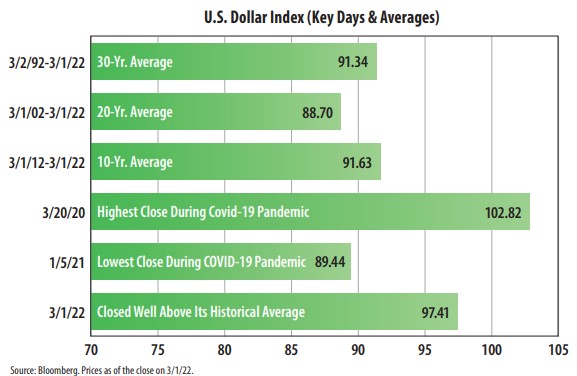
View from the Observation Deck
1. We get asked from time to time what our take is on the U.S. dollar and where we think it may be headed next.
2. The dollar is still regarded as the world's primary reserve currency. Its relative strength over time can be influenced by such things as central bank monetary policy, geopolitics and trade.
3. U.S. investors with exposure to foreign securities, commodities and the stocks of U.S. multinational companies are particularly vulnerable to fluctuations in the U.S. dollar.
4. Predicting the direction of the dollar, or any currency, can be a daunting task, even for professionals who specialize in it. One thing we can provide is some context.
5. As indicated in the chart above, as of 3/1/22, the 10-, 20- and 30-year averages for the U.S. Dollar Index registered readings of 91.63, 88.70 and 91.34, which is a relatively tight range over a span of 30 years. The average of the three averages is 90.56.
6. To add some additional context, over the past 30 years, the index peaked at a reading of 120.90 on 7/5/01, while hitting a period-low of 71.33 on 4/22/08, according to Bloomberg.
7. A recent survey of 43 strategists by Reuters found that the strategists expect the U.S. dollar to “reign supreme” for at least another 3-6 months, which is to say
that those polled expect it to at least hold its current relative value. For it to trend higher, they feel that the Federal Reserve would need to take a more
aggressive tone with respect to future rate hikes than it has to date.



